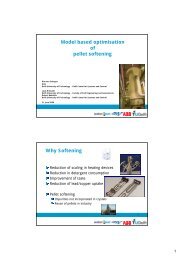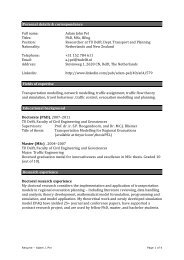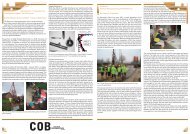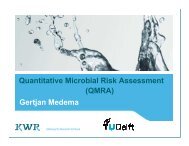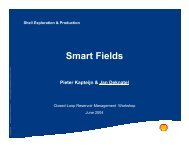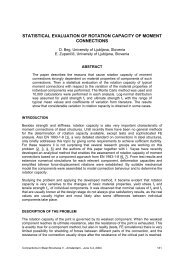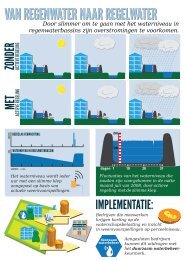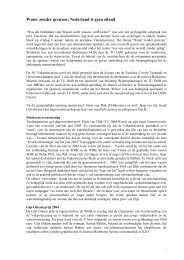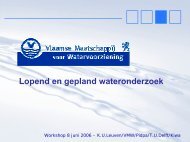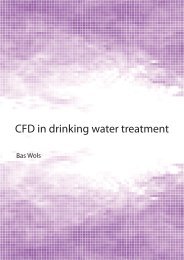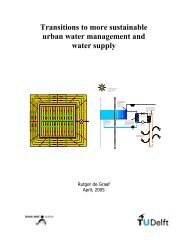Hydrological modelling of the Zambezi catchment for ... - TU Delft
Hydrological modelling of the Zambezi catchment for ... - TU Delft
Hydrological modelling of the Zambezi catchment for ... - TU Delft
You also want an ePaper? Increase the reach of your titles
YUMPU automatically turns print PDFs into web optimized ePapers that Google loves.
SUMMARY<br />
The second rainfall-algorithm is <strong>the</strong> FEWS RFE 1.0. This algorithm first estimates <strong>the</strong> rainfall<br />
based on <strong>the</strong>rmal Infrared data with <strong>the</strong> GPI-algorithm. Next, <strong>the</strong> estimates are corrected by<br />
fitting <strong>the</strong> values to ground stations. Finally, an orographic lifting and humidity model is<br />
applied on <strong>the</strong> estimates. A comparison between <strong>the</strong> RFE 1.0 estimates and <strong>the</strong> observed data<br />
shows that <strong>the</strong> algorithm overestimates <strong>the</strong> rainfall somewhat. However, <strong>the</strong> correlation<br />
coefficient is 0.85, which is quite low compared to <strong>the</strong> o<strong>the</strong>r algorithms.<br />
The last algorithm, which has been investigated, is <strong>the</strong> FEWS RFE 2.0. This algorithm first<br />
estimates <strong>the</strong> rainfall separately on three satellite sources: Special Sensor Microwave/Imager,<br />
AMSU-A microwave and METEOSAT Infrared. Next <strong>the</strong> estimated are weighted to reduce<br />
<strong>the</strong> error. The last step is to correct <strong>the</strong> weighted estimates with observed data. The<br />
per<strong>for</strong>mance <strong>of</strong> <strong>the</strong> RFE 2.0 is very good, with a correlation coefficient <strong>of</strong> 0.97 and a very<br />
little overestimation.<br />
Finally after a comparison between <strong>the</strong> algorithms, <strong>the</strong> corrected MIRA-algorithm is chosen<br />
<strong>for</strong> <strong>the</strong> period 1993-2000 and <strong>the</strong> FEWS RFE 2.0 <strong>for</strong> <strong>the</strong> period 2001-2003. For <strong>the</strong> period<br />
be<strong>for</strong>e 1993 interpolated rainfall data from ground stations is used.<br />
The hydrological model, which is built, consists <strong>of</strong> two sub models: a water balance model<br />
created in STREAM and a Muskingum routing model. The water balance model is a storage<br />
reservoir model, which contains three levels. First, <strong>the</strong> shallow soil from where interception<br />
takes place. Second, <strong>the</strong> unsaturated zone with <strong>the</strong> transpiration process and third, <strong>the</strong><br />
saturated zone. From <strong>the</strong> saturated zone three ground water outflows are implemented: <strong>the</strong><br />
saturation overland flow, <strong>the</strong> quick flow and <strong>the</strong> slow flow.<br />
The model is only calibrated <strong>for</strong> <strong>the</strong> western part <strong>of</strong> <strong>the</strong> <strong>catchment</strong> on <strong>the</strong> locations Lukulu<br />
and Victoria Falls, because in <strong>the</strong> western part less influence <strong>of</strong> tides exists. Looking at <strong>the</strong><br />
results it can be concluded that <strong>the</strong> model is quite reasonable in simulating <strong>the</strong> discharge with<br />
a Nash-Suttcliffe coefficient <strong>of</strong> 0.70 and 0.68 <strong>for</strong> Lukulu and Victoria Falls respectively.<br />
However <strong>the</strong> model underestimates <strong>the</strong> discharge slightly, especially <strong>the</strong> high peaks.<br />
GLUE<br />
To obtain more knowledge about <strong>the</strong> sensitivity <strong>of</strong> <strong>the</strong> model, <strong>the</strong> GLUE-procedure (Beven,<br />
1989) is used twice. First, <strong>the</strong> procedure is carried out on <strong>the</strong> uncertainty <strong>of</strong> four parameters<br />
and second, <strong>the</strong> procedure was executed <strong>for</strong> <strong>the</strong> uncertainty in <strong>the</strong> precipitation and potential<br />
evaporation input data <strong>of</strong> <strong>the</strong> <strong>Zambezi</strong> model.<br />
viii



